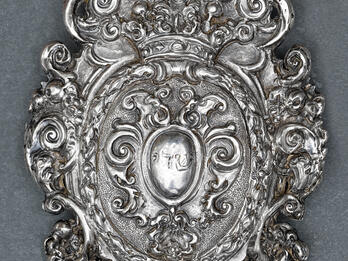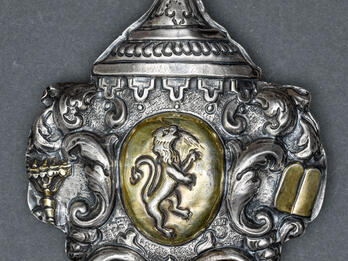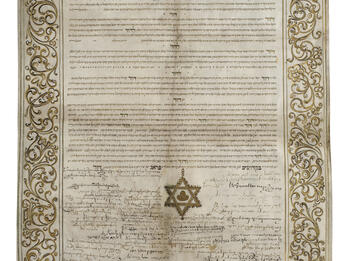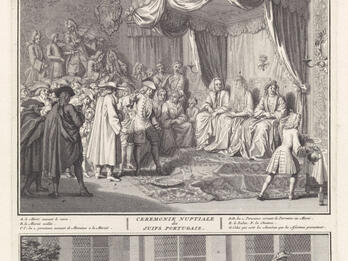Tefilah mi-kol ha-shanah me-ha-ari (Prayer for the Whole Year According to the Ari)
Artist Unknown
ca. 1750
Isaac Luria , known as “the holy ARI” (an acronym of his name, meaning “lion”), was one of the most significant figures in Jewish mysticism, famed for pioneering a new conception of theoretical kabbalah. Luria was born in Jerusalem and, following the death of his father, was raised by his maternal family in Egypt. There Luria studied rabbinic literature and halakhah, while working as a merchant. He embarked on esoteric studies and lived in seclusion on an island in the Nile (allegedly for seven years). In 1569/70, he settled in Safed, where he studied kabbalah with Moses Cordovero. Luria soon began to develop his own innovative kabbalistic system. However, aside from delivering a few homilies in synagogues, he did not often teach in public. Luria himself wrote very little; his teachings were recorded by the disciples who gathered around him.

Credits
Courtesy GFC Trust / William L. Gross.
Published in: The Posen Library of Jewish Culture and Civilization, vol. 5.
You may also like

Amulet for a Newborn Boy
This printed amulet, from Germany, was made for infant boys. The amulet has a companion, for a girl child (see “Amulet for a Newborn Girl”). The text in the center of the amulet is surrounded by a…
![14. [Image: M14 626 An amulet for a newly born female child] Printed page with Hebrew text in the middle surrounded by floral design and figures.](/system/files/styles/entry_card_sm_1x/private/images/vol05/Posen5_blackandwhite169_color.jpg?h=55b496cd&itok=ZMzRFnve)
Amulet for a Newborn Girl
Printed amulet for an infant girl from Germany. It was (presumably) printed alongside its companion amulet for a male child (see “Amulet for a Newborn Boy”). However, the pair were separated. A woman…

Amulet for Mother and Child
This German amulet is printed with unique designs. The names of the three angels, Sanoi, Sansanoi, and Smangalaf, indicate the use of this amulet as birth protection for mother and child, as…

Amulet to Be Hung over the Crib of a Newborn
The Hebrew word Shaddai—another name for God—is etched in the center of this ornate silver amulet from Italy.

Amulet with Coat of Arms
Silver amulet typical of eighteenth- and nineteenth-century Italian Jewish homes. This example from Venice is unusual in that it contains an unidentified family coat of arms whose main feature is a…
![13. [Image: M13 625 Birth amulet]. Birth amulet Printed page with Hebrew text surrounded by decorative floral border.](/system/files/styles/entry_card_sm_1x/private/images/vol05/Posen5_blackandwhite173_color.jpg?h=164f6735&itok=juH6L9Q1)
Birth Amulet (Fürth)
Printed birth amulet. The decorative borders are composed of printers’ devices and decorations that were used by printers in Fürth (Bavaria), so it is assumed that this amulet was printed in that city…
Engage with this Source
Public Access
Image
Language:
Places:
Eastern Europe

Related Guide
Early Modern Rabbis and Intellectuals on the Move
1500–1750
Carrying books and knowledge, itinerant rabbis and scholars traveled between communities, facilitating cultural exchange.

Related Guide
Early Modern Religious Practices
1500–1750
Early modern Jews both preserved tradition and innovated. Documents and legal texts reveal rich details about synagogue life, marriage, family relations, and death rituals.
You may also like

Amulet for a Newborn Boy
This printed amulet, from Germany, was made for infant boys. The amulet has a companion, for a girl child (see “Amulet for a Newborn Girl”). The text in the center of the amulet is surrounded by a…
![14. [Image: M14 626 An amulet for a newly born female child] Printed page with Hebrew text in the middle surrounded by floral design and figures.](/system/files/styles/entry_card_sm_1x/private/images/vol05/Posen5_blackandwhite169_color.jpg?h=55b496cd&itok=ZMzRFnve)
Amulet for a Newborn Girl
Printed amulet for an infant girl from Germany. It was (presumably) printed alongside its companion amulet for a male child (see “Amulet for a Newborn Boy”). However, the pair were separated. A woman…

Amulet for Mother and Child
This German amulet is printed with unique designs. The names of the three angels, Sanoi, Sansanoi, and Smangalaf, indicate the use of this amulet as birth protection for mother and child, as…

Amulet to Be Hung over the Crib of a Newborn
The Hebrew word Shaddai—another name for God—is etched in the center of this ornate silver amulet from Italy.

Amulet with Coat of Arms
Silver amulet typical of eighteenth- and nineteenth-century Italian Jewish homes. This example from Venice is unusual in that it contains an unidentified family coat of arms whose main feature is a…
![13. [Image: M13 625 Birth amulet]. Birth amulet Printed page with Hebrew text surrounded by decorative floral border.](/system/files/styles/entry_card_sm_1x/private/images/vol05/Posen5_blackandwhite173_color.jpg?h=164f6735&itok=juH6L9Q1)
Birth Amulet (Fürth)
Printed birth amulet. The decorative borders are composed of printers’ devices and decorations that were used by printers in Fürth (Bavaria), so it is assumed that this amulet was printed in that city…


![18. [Image: M18 635 Tefilah mi-kol ha-shanah me-ha-ari]. Tefilah me kol ha-shanah me-ha-ari Facing-page manuscript with Hebrew text and small geometric shape with rectangle and small concentric circles on left-hand page.](/system/files/styles/prose_image_x2/private/images/vol05/Posen5_blackandwhite174_color.jpg?itok=XSCyFHV2)